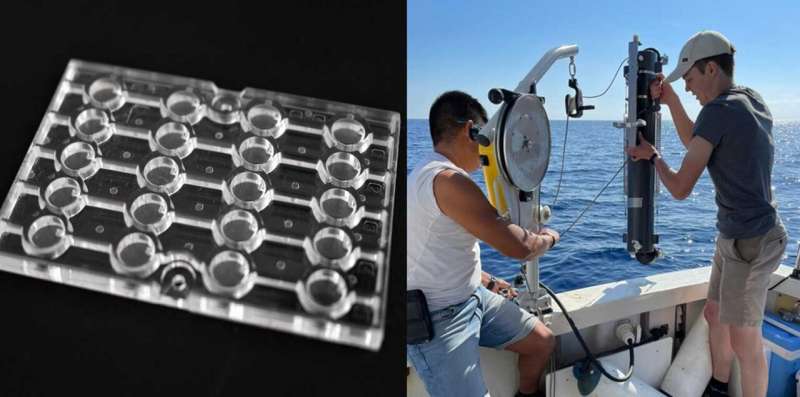This article has been reviewed according to Science X's editorial process and policies. Editors have highlighted the following attributes while ensuring the content's credibility:
fact-checked
peer-reviewed publication
trusted source
proofread
Microfluidic chip reveals that bacteria swim toward large, complex polymers

Using a novel microfluidic chip, ETH researchers led by Professor Roman Stocker and Estelle Clerc have shown that bacteria not only recognize small food molecules, but also swim towards large, complex polymers. A startup is now using these findings and applying the technology to find microbes in the environment that can break down pollutants.
Scientists have known for some time that bacteria can move around in aqueous solutions thanks to very fine cilia on their surface. Until now, however, experts have assumed that the microbes are blind to complex polymers. And that they only orientate themselves toward highly diffusible substances such as simple sugars that are very easily metabolized or eaten up.
Conventional wisdom refuted
But now the findings of Roman Stocker's research team at the Department of Civil, Environmental and Geomatic Engineering (D-BAUG) at ETH Zurich have disproved the conventional wisdom. Using a microfluidic chip co-developed with their collaborators at UTS Sydney, consisting of a credit card-sized plastic plate with small chambers inside, the researchers have shown during field work in the Norwegian Raunefjord that bacterial communities follow the concentration gradient of laminarin and other complex polysaccharides.
Laminarin is found in numerous species of microscopic brown algae and other members of marine phytoplankton. Laminarin contains up to a quarter of the carbon that is bound by photosynthesis in the oceans. "Laminarin is therefore one of the most important food sources for marine bacteria," says Estelle Clerc, postdoctoral fellow in Stocker's research group and first author of the study recently published in Nature Communications.
Well-developed sensorium
The fact that marine microbes can actively swim towards complex molecules to break them down has not yet been taken into account in models of global carbon fluxes. Their new results might therefore play a role in the future calculation of climate scenarios, says Clerc. But in addition to that, the evidence that microbes have a better developed sensorium than previously assumed gave Clerc the next idea. "Perhaps bacteria also recognize other complex and poorly degradable substances."
To test the theory, the researchers simply had to equip their instrument with such substances—and then release it in the water at various locations (such as in Lake Zurich or in the basin of a wastewater treatment plant). Her initial, still preliminary and unpublished results show that there are indeed bacterial communities in the environment that are attracted to microplastics or pesticide residues, for example.
Solutions in the field of environmental remediation
"Our instrument works like a bacterial trap," says Clerc. "The advantage is that we can use it to isolate bacterial communities with specific metabolic capabilities," says Clerc. Some of these bacterial communities appear to be able to utilize the nasty chemicals. "In our initial feasibility tests, some of the bacteria increased their biomass up to 20,000-fold, even though the pollutants were the only food source available to them," says Clerc.
Two years ago, Clerc founded a spin-off company, CellX Biosolutions, to use the bacterial trap to specifically search for microorganisms that can be used for environmental remediation. In addition to pesticides and microplastics, the company is also focusing on pharmaceuticals and the notorious PFAS, which are often referred to as "eternal chemicals" because of their stability.
The ultimate goal of the startup is to commercialize these bacterial degraders as products that can be utilized in various industries as an alternative to current unsustainable and costly methods of toxic chemical disposal, such as incineration.
CellX has recently reached an important milestone in its product development. Clerc is currently planning pilot trials with two major industrial partners, tailored to the specific treatment needs of these collaborators. As a next step, Clerc intends to move into industrial applications.
In collaboration with the D-BAUG technical team, Clerc has also developed a pressure-resistant housing for the microfluidic chip for use in the deep sea. A patent application is currently pending. "With this housing we can access extreme environments such as the eternal darkness of the oceans at a depth of 4,000 meters," says Clerc. "This gives us access to a huge reservoir of bacteria with metabolic capabilities that are still largely unexplored."
More information: Estelle E. Clerc et al, Strong chemotaxis by marine bacteria towards polysaccharides is enhanced by the abundant organosulfur compound DMSP, Nature Communications (2023). DOI: 10.1038/s41467-023-43143-z
Journal information: Nature Communications
Provided by ETH Zurich


















